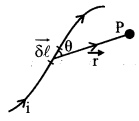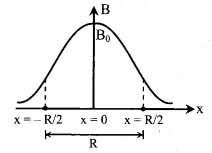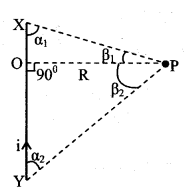Magnetic Effect of Current Formulas
Not Everyone feels comfortable to understand the concept of Magnetic Effect of Current. To help such people we have jotted down the Magnetic Effect of Current Formulas. The Formulae Sheet & Tables on Magnetic Effect of Current provided covers Biot-savartΓÇÖs law, Ampere's Law, Motion of Charged Particle in a Magnetic Field, etc. You will no more feel the concept of the Magnetic Effect of Current horror again with the list of formulas prevailing. Avail the Physics Formulas to get a good grip on several related concepts with ease.
Magnetic Effect of Current Formulae Sheet
1. Biot-savartΓÇÖs law
The magnetic field at a certain point due to an element ╬┤l of a current-carrying conductor is

╬┤B = \(\frac{\mu_{0}}{4 \pi} \frac{i \delta \ell \sin \theta}{r^{2}}\)
or \(\overrightarrow{\mathrm{d} \mathrm{B}}=\frac{\mu_{0}}{4 \pi} \frac{\mathrm{i} \delta \vec{\ell} \times \hat{\mathrm{r}}}{\mathrm{r}^{2}}\)
= \(\frac{\mu_{0}}{4 \pi} \frac{i \delta \vec{\ell} \times \vec{r}}{r^{3}}\)
╬┤\(\overrightarrow{\mathrm{B}}\) is in a direction normal to the plane of ╬┤\(\vec{\ell} \text { and } \vec{r}\)
2. Magnetic field due to a current caryying circular coil
(a) At the centre
B0 = \(\frac{\mu_{0} \mathrm{ni}}{2 \mathrm{R}}\) along the axis of coil.
(b) At a point on the axis of a coil
B = \(\frac{\mu_{0} n i R^{2}}{2\left(R^{2}+x^{2}\right)^{3 / 2}}\)
(c) If x > > R, then
B = \(\frac{\mu_{0} \mathrm{niR}^{2}}{2 \mathrm{x}^{3}}\)

(d) At the point of inflexion, \(\frac{\mathrm{dB}}{\mathrm{dx}}\) = constant or \(\frac{d^{2} B}{d x^{2}}\) inflection are found in the field of a coil at x = ┬▒ R/2 and the distance between them is equal to the radius of the coil.
3. Magnetic field due to a current carrying straight wire of finite length

B = \(\frac{\mu_{0} \mathrm{i}}{4 \pi \mathrm{R}}\) (sin ╬▓1 + sin ╬▓2)
or B = \(\frac{\mu_{0} \mathrm{i}}{4 \pi \mathrm{R}}\) (cos ╬▒1 + cos ╬▒2)
4. Magnetising field (\(\overrightarrow{\mathrm{H}}\))
\(\overrightarrow{\mathrm{H}}=\overrightarrow{\mathrm{B}} / \mu_{0}\)5. AmpereΓÇÖs law
(a) The line integral of magnetic field along the closed path = p0 multiple of net current passing through that closed path
\(\oint \overrightarrow{\mathrm{B}} \cdot \mathrm{d} \vec{\ell}=\mu_{0} \Sigma \mathrm{I}\)
(b) Magnetomotive force
Fm = \(\oint \overrightarrow{\mathrm{H}} \cdot \mathrm{d} \vec{\ell}=\frac{1}{\mu} \oint \overrightarrow{\mathrm{B}} \cdot \mathrm{d} \vec{\ell}\)
6. Magnetic field due to a current carrying straight wire of infinite length
B = \(\frac{\mu_{0} i}{2 \pi r}=\frac{\mu_{0}}{4 \pi} \frac{2 i}{r}\)
7. Magnetic field due to a current carrying long and straight solid cylinder
- At a point out side the cylinder Bout = \(\frac{\mu_{0} i}{2 \pi r}\)
- At the surface Bsurface = \(\frac{\mu_{0} i}{2 \pi R}\)
- At a point inside the cylinder Bin = \(\frac{\mu_{0} \mathrm{ir}}{2 \pi \mathrm{R}^{2}}\) ; R → Radius of cylinder.
8. Magnetic field due to a current carrying long and straight hollow cylinder
(a) At a point out side the cylinder
Bout = \(\frac{\mu_{0} i}{2 \pi r}\)
9. Magnetic behaviour of current carrying coil and its magnetic moment
- A small current carrying coil behaves like a small magnet.
- Magnetic moment of a current carrying coil
M = current × effective area.
For a coil of N turns
M = NiA = NiπR2
10. Current and magnetic field due to circular motion of charge
(a) Current i = ef = \(\frac{\mathrm{e}}{\mathrm{T}}\)
f → revolution/second, T → Time period
i = \(\frac{\mathrm{e} \omega}{2 \pi}=\frac{\mathrm{ev}}{2 \pi \mathrm{R}}\)
(b) Magnetic field B0 = \(\frac{\mu_{0} n I}{2 R}=\frac{\mu_{0} n e f}{2 R}=\frac{\mu_{0} n e}{2 R T}\)
B0 = \(\frac{\mu_{0} \text { ne } \omega}{4 \pi R}=\frac{\mu_{0} \text { nev }}{4 \pi R^{2}}\) (e → charge of electron)
(c) Magnetic moment
M = iA = efπR2 = \(\frac{\mathrm{e} \pi \mathrm{R}^{2}}{\mathrm{T}}\)
M = \(\frac{\mathrm{e} \omega \mathrm{R}^{2}}{2}=\frac{\mathrm{evR}}{2}=\frac{\mathrm{eL}}{2 \mathrm{m}}\)
L → angular momentum, m → mass of electron
11. Force on a current carrying condcutor due to magnetic field
\(\overrightarrow{\mathrm{F}}=\mathrm{i}(\vec{\ell} \times \overrightarrow{\mathrm{B}})\)
\(|\overrightarrow{\mathrm{F}}|\) = i l B sin ╬╕
Two parallel conductors carrying currents in the same direction attract each other but with currents in opposite direction repel each other.
12. Magnetic force between two parallel current-carrying conductors
Attractive or repulsive force on unit length of conductors
\(\frac{F}{\ell}=\frac{\mu_{0} i_{1} i_{2}}{2 \pi d}\)
d → distance between parallel conductors.
13. Motion of charged particle in a magnetic field
(a) Force on the particle
\(\overrightarrow{\mathrm{F}}=\mathrm{q}(\overrightarrow{\mathrm{v}} \times \overrightarrow{\mathrm{B}})\)
\(|\overrightarrow{\mathrm{F}}|\) = qvB sin ╬╕
(b) when ╬╕ = 90┬░, the motion of particle will be along a circular path. Radius of circular path
R = \(\frac{m v}{q B}=\frac{\sqrt{2 m E}}{q B}=\frac{\sqrt{2 m q V}}{q B}\)
Period of revolution of the particle
T = \(\frac{2 \pi \mathrm{m}}{\mathrm{qB}}\)
Frequency of revolution
f = \(\frac{1}{\mathrm{T}}=\frac{\mathrm{qB}}{2 \pi \mathrm{m}}\)
Kinetic energy of the particle
E = \(\frac{\mathrm{R}^{2} \mathrm{q}^{2} \mathrm{B}^{2}}{2 \mathrm{m}}\)
14. Interaction between two moving charges
(a) Magnetic field due to charge moving with velocity \(\overrightarrow{\mathrm{v}}\)
\(\overrightarrow{\mathrm{B}}=\frac{\mu_{0}}{4 \pi} \frac{\mathrm{q}(\overrightarrow{\mathrm{v}} \times \overrightarrow{\mathrm{r}})}{\mathrm{r}^{3}}\)
Hence B = \(\frac{\mu_{0}}{4 \pi} \frac{q v \sin \theta}{r^{2}}\)
(b) The electric and magnetic forces both act between moving charges.
(c) Electric force Fe = \(\frac{1}{4 \pi \epsilon_{0}} \frac{q_{1} q_{2}}{r^{2}}\)
(d) Magnetic force Fm = \(\frac{\mu_{0}}{4 \pi} \frac{\mathrm{q}_{1} \mathrm{q}_{2} \mathrm{v}_{1} \mathrm{v}_{2}}{\mathrm{r}^{2}}\)
If v1 = v2 = v
then Fm = \(\frac{\mu_{0}}{4 \pi} \frac{q_{1} q_{2}}{r^{2}} v^{2}\)
(e) \(\frac{F_{m}}{F_{e}}=\frac{v^{2}}{c^{2}}=\left(\frac{v}{c}\right)^{2}\)
Stationary Charges:

Moving Charges:

15. Force and torque on a current-carrying coil placed in a uniform magnetic field
(a) resultant force Fnet = 0.
(b) A torque acts on the coil
τ = iNAB sin θ = MB sin θ
M → magnetic dipole moment.
In vector form
τ = \(\overrightarrow{\mathrm{M}} \times \overrightarrow{\mathrm{B}}\)
(c) The work done in turning a loop from angle ╬╕1 to ╬╕2.
W = MB (cos ╬╕1 – cos ╬╕2)
(d) Time period of oscillation of a magnetic dipole in uniform M.F.
T = 2π\(\sqrt{\frac{\mathrm{I}}{\mathrm{MB}}}\); I → moment of inertia
Get instant help regarding formulas of various concepts from Physics all at one place on Physicscalc.Com a trusted and reliable portal.